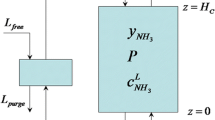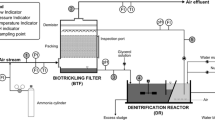Abstract
The removal of styrene-polluted air emissions by biotrickling filtration was performed to evaluate the influence of using nitrate and urea as a nitrogen source in the nutrient solution supplied to two bioreactors run in parallel under the same operational conditions for 3 months. The use of urea resulted in less biomass content along the packed bed and better performance of the process, with a maximum elimination capacity (EC) of 57.6 g C m−3 h−1 (removal efficiency (RE) of 88.3% and empty bed residence time (EBRT) of 60 s), which was around 54% higher than when using nitrate. EBRTs of 60, 30 and 15 s were evaluated with a urea-based nutrient supply. By decreasing the EBRT from 60 to 30 s the styrene concentration that could be treated with REs above 80% was almost the half, from 1,100 to 600 mg C m−3, resulting in ECs of 52.8 g C m−3 h−1. Working at 15 s was not possible to obtain REs higher than 40% with a maximum EC of 28.5 g C m−3 h−1.






Similar content being viewed by others
References
Paca J, Koutsky B, Maryska M, Halecky M (2001) Styrene degradation along the bed height of perlite biofilter. J Chem Technol Biotechnol 76:873–878
Miller RR, Newhook R, Poole A (1994) Styrene production, use, and human exposure. Crit Rev Toxicol 24:1–10
United States Environmental Protection Agency (1994) OPPT fact sheets, styrene fact sheets: support document. US-EPA 749-F-95-019a
European Commission (2010). Directive 2010/75/EU of the European Parliament and of the Council of 24 November 2010 on industrial emissions (integrated pollution prevention and control). Off J Eur Union L334:17–119
European Commission (2003). IPPC reference document on best availabe techniques in common waste water and gas treatment/management system in the chemical sector. European IPPC Bureau, Sevilla
Devinny JS, Deshusses MA, Webster TS (1999) Biofiltration for air pollution control. CRC-Lewis Publishers, Boca Raton
Kennes C, Rene ER, Veiga MC (2009) Bioprocesses for air pollution control. J Chem Technol Biotechnol 84:1419–1436
Lu C, Lin M, Chu C (2002) Effects of pH, moisture, and flow pattern on trickle-bed air biofilter performance for BTEX removal. Adv Environ Res 6:99–106
Rene ER, López ME, Veiga MC, Kennes C (2010) Performance of a fungal monolith bioreactor for the removal of styrene from polluted air. Bioresour Technol 101:2608–2615
Iranpour R, Cox HHJ, Deshusses MA, Schroeder ED (2005) Literature review of air pollution control biofilters and biotrickling filters for odor and volatile organic compound removal. Environ Prog 24:254–267
Paca J, Klapkova E, Halecky M, Jones K, Webster TS (2006) Interactions of hydrophobic and hydrophilic solvent component degradation in an air-phase biotrickling filter reactor. Environ Prog 25:365–372
Kim D, Cai ZL, Sorial GA (2005) Evaluation of trickle-bed air biofilter performance under periodic stressed operating conditions as a function of styrene loading. J Air Waste Manage Assoc 55:200–209
Sempere F, Gabaldón C, Martínez-Soria V, Marzal P, Penya-roja JM, Álvarez-Hornos FJ (2008) Performance evaluation of a biotrickling filter treating a mixture of oxygenated VOCs during intermittent loading. Chemosphere 73:1533–1539
Atoche JC, Moe WM (2004) Treatment of MEK and toluene mixtures in biofilters: effect of operating strategy on performance during transient loading. Biotechnol Bioeng 86:468–481
Sempere F, Gabaldón C, Martínez-Soria V, Penya-roja JM, Álvarez-Hornos FJ (2009) Evaluation of a combined activated carbon prefilter and biotrickling filter system treating variable ethanol and ethyl acetate gaseous emissions. Eng Life Sci 9:317–323
Choi DS, Devinny JS, Deshusses MA (2004) Behavior of field-scale biotrickling filter under nonsteady state conditions. J Environ Eng-ASCE 130:322–328
Martínez-Soria V, Gabaldon C, Penya-roja JM, Palau J, Álvarez-Hornos FJ, Sempere F, Soriano C (2009) Performance of a pilot-scale biotrickling filter in controlling the volatile organic compound emissions in a furniture manufacturing facility. J Air Waste Manage Assoc 59:998–1006
Popov VO, Bezborodov AM, Cavanagh M, Cross P (2004) Evaluation of industrial biotrickling filter at the flexographic printing facility. Environ Prog 23:39–44
Santos S, Jones K, Abdul R, Boswell J, Paca J (2007) Treatment of wet process hardboard plant VOC emissions by a pilot scale biological system. Biochem Eng J 37:261–270
Steele JA, Ozis F, Fuhrman JA, Devinny JS (2005) Structure of microbial communities in ethanol biofilters. Chem Eng J 113:135–143
Cox HHJ, Sexton T, Shareefdeen ZM, Deshusses MA (2001) Thermophilic biotrickling filtration of ethanol vapors. Environ Sci Technol 35:2612–2619
Liu Q, Babajide AE, Zhu P, Zou LP (2006) Removal of xylene from waste gases using biotrickling filters. Chem Eng Technol 29:320–325
Tresse O, Lescob S, Rho D (2003) Dynamics of living and dead bacterial cells within a mixed-species biofilm during toluene degradation in a biotrickling filter. J Appl Microbiol 94:849–855
Álvarez-Hornos FJ, Gabaldón C, Martínez-Soria V, Marzal P, Penya-roja JM, Sempere F (2007) Biofiltration of ethyl acetate under continuous and intermittent loading. Environ Prog 26:327–337
Jorio H, Bibeau L, Heitz M (2000) Biofiltration of air contaminated by styrene: effect of nitrogen supply, gas flow rate, and inlet concentration. Environ Sci Technol 34:1764–1771
Wang C, Xi J, Hu H (2009) Effects of nitrogen source, empty bed residence time and inlet concentration on biofilter removal of chlorobenzene. Eng Life Sci 9:109–115
Song J, Ramirez J, Kinney KA (2003) Nitrogen utilization in a vapor-phase biofilter. Water Res 37:4497–4505
Yang H, Minuth B, Allen DG (2002) Effects of nitrogen and oxygen on biofilter performance. J Air Waste Manage Assoc 52:279–286
Delhoménie MC, Bibeau L, Roy S, Brzezinski R, Heitz M (2001) Influence of nitrogen on the degradation of toluene in a compost-based biofilter. J Chem Technol Biotechnol 76:997–1006
Sorial GA, Smith FL, Suidan MT, Pandit A, Biswas P, Brenner RC (1998) Evaluation of trickle-bed air biofilter performance for styrene removal. Water Res 32:1593–1603
Clesceri LS, Greenberg AE, Eaton AD (1998). Standard methods for the examination of water and wastewater, 20th edn. American Public Health Association, American Water Works Association and Water Environment Federation, Washington
Grady CPL, Daigger GT, Lim HC (1999) Biological wastewater treatment, 2nd edn. Marcel Dekker Inc, New York
Rene ER, Veiga MC, Kennes C (2009) Performance of a biofilter for the removal of high concentrations of styrene under steady and non-steady state conditions. J Hazard Mater 168:282–290
Kim J, Ryu HW, Jung DJ, Lee TH, Cho K-S (2005) Styrene degradation in a polyurethane biofilter inoculated with Pseudomonas sp. IS-3. J Microbiol Biotechn 15:1207–1213
Hwang JW, Choi CY, Park S, Lee EY (2008) Biodegradation of gaseous styrene by Brevibacillus sp using a novel agitating biotrickling filter. Biotechnol Lett 30:1207–1212
Acknowledgments
Financial support by the Ministerio de Educación y Ciencia (Spain, research project CTM 2010-15031 with FEDER funds) is acknowledged. Feliu Sempere and Jordi Palau thank the Universitat de València and Generalitat Valenciana (Spain) for the award of their respective pre-doctoral fellowships.
Author information
Authors and Affiliations
Corresponding author
Rights and permissions
About this article
Cite this article
Sempere, F., Martínez-Soria, V., Palau, J. et al. Effects of nitrogen source and empty bed residence time on the removal of styrene gaseous emissions by biotrickling filtration. Bioprocess Biosyst Eng 34, 859–867 (2011). https://doi.org/10.1007/s00449-011-0536-9
Received:
Accepted:
Published:
Issue Date:
DOI: https://doi.org/10.1007/s00449-011-0536-9




